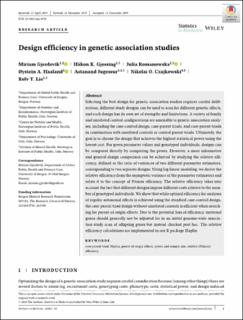| dc.contributor.author | Gjerdevik, Miriam | |
| dc.contributor.author | Gjessing, Håkon K. | |
| dc.contributor.author | Romanowska, Julia | |
| dc.contributor.author | Haaland, Øystein Ariansen | |
| dc.contributor.author | Jugessur, Astanand | |
| dc.contributor.author | Czajkowski, Nikolai Olavi | |
| dc.contributor.author | Lie, Rolv T. | |
| dc.date.accessioned | 2021-02-05T08:21:14Z | |
| dc.date.available | 2021-02-05T08:21:14Z | |
| dc.date.created | 2020-03-10T09:38:53Z | |
| dc.date.issued | 2020 | |
| dc.Published | Statistics in Medicine. 2020, 39 (9), 1292-1310. | en_US |
| dc.identifier.issn | 0277-6715 | |
| dc.identifier.uri | https://hdl.handle.net/11250/2726302 | |
| dc.description.abstract | Selecting the best design for genetic association studies requires careful deliberation; different study designs can be used to scan for different genetic effects, and each design has its own set of strengths and limitations. A variety of family and unrelated control configurations are amenable to genetic association analyses, including the case‐control design, case‐parent triads, and case‐parent triads in combination with unrelated controls or control‐parent triads. Ultimately, the goal is to choose the design that achieves the highest statistical power using the lowest cost. For given parameter values and genotyped individuals, designs can be compared directly by computing the power. However, a more informative and general design comparison can be achieved by studying the relative efficiency, defined as the ratio of variances of two different parameter estimators, corresponding to two separate designs. Using log‐linear modeling, we derive the relative efficiency from the asymptotic variance of the parameter estimators and relate it to the concept of Pitman efficiency. The relative efficiency takes into account the fact that different designs impose different costs relative to the number of genotyped individuals. We show that while optimal efficiency for analyses of regular autosomal effects is achieved using the standard case‐control design, the case‐parent triad design without unrelated controls is efficient when searching for parent‐of‐origin effects. Due to the potential loss of efficiency, maternal genes should generally not be adjusted for in an initial genome‐wide association study scan of offspring genes but instead checked post hoc. The relative efficiency calculations are implemented in our R package Haplin. | en_US |
| dc.language.iso | eng | en_US |
| dc.publisher | Wiley | en_US |
| dc.rights | Navngivelse 4.0 Internasjonal | * |
| dc.rights.uri | http://creativecommons.org/licenses/by/4.0/deed.no | * |
| dc.title | Design efficiency in genetic association studies | en_US |
| dc.type | Journal article | en_US |
| dc.type | Peer reviewed | en_US |
| dc.description.version | publishedVersion | en_US |
| dc.rights.holder | Copyright 2020 The Authors. | en_US |
| cristin.ispublished | true | |
| cristin.fulltext | original | |
| cristin.qualitycode | 2 | |
| dc.identifier.doi | 10.1002/sim.8476 | |
| dc.identifier.cristin | 1800788 | |
| dc.source.journal | Statistics in Medicine | en_US |
| dc.source.40 | 39 | en_US |
| dc.source.14 | 9 | en_US |
| dc.source.pagenumber | 1292-1310 | en_US |

